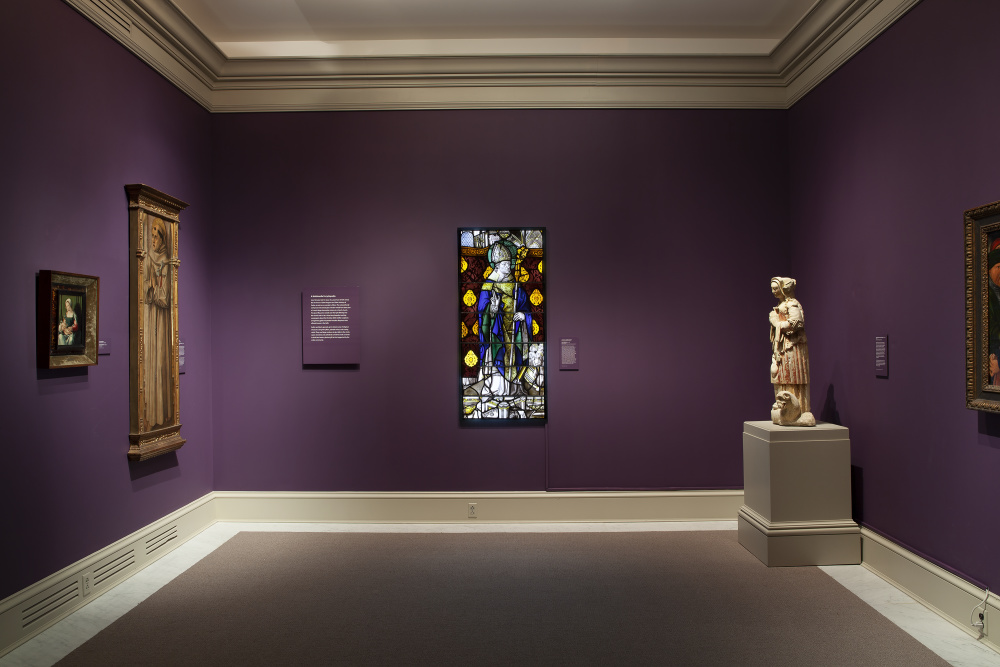- Open today, 10 am to 5 pm.
- Parking & Directions
- Free Admission
Object of the Week: Saint Nicholas

European Gallery, Gallery 202, with Saint Nicholas
An outstanding example of French Renaissance stained glass was added to the Chrysler Museum’s permanent collection last fall. The format, setting, and decorative scheme of the panel are indicative of the workshops of Rouen in northern France, a region whose mastery of the medium was widely acknowledged. Stylistic characteristics like the color palette, figural rendering, and meticulous approach to shading help date the window to ca. 1470 and point specifically to the workshop of glazier Guillaume Barbe, who is documented in Rouen between 1456–88. The extraordinarily well-preserved window is of monumental size and features Saint Nicholas (270–342 CE), an early Christian bishop from the city of Myra in what is now modern Turkey. The legendary figure’s generosity later inspired the person of Santa Claus.
Stained glass windows are made from flat sections of glass cut from different colors and joined together like a jigsaw puzzle using flexible lead strips. The window is stabilized and secured to its architectural setting with metal braces and cement. The Saint Nicholas panel includes vivid blue, green, purple, and red glass as well as colorless glass that has been decorated on its surface with silver stain and vitreous enamels. When heated, the silver compound that is painted on the colorless glass turns shades of yellow, hence the term “stained” glass. Black vitreous enamel, made of crushed glass mixed with a binder, can be painted onto the surface of the glass and heated until fused, allowing the artist to create painterly details by means of line and shading.
The meticulous approach to shading the figure’s facial features are characteristic of Barbe’s work: the dense shading and puffy bags beneath the eyes, thick black outlines of the eyelids, mouth parted, nose slightly hooked, and long earlobes with outward-curving lobes. These elements can be found in several windows dating to the late 1460s that have authorship firmly documented to Barbe’s workshop. There are similarities in the livery of the figure and in the architectural details. For example, the use of a complex faceted dias beneath the saint’s feet and details on the architectural moldings point to Barbe’s workshop.

Attributed to Guillaume Barbe (French, documented 1456–1488), Saint Nicholas, ca. 1470, Glass with silver stain and vitreous enamel, Museum purchase, 2019.36.1
To its audience, the figure depicted in this fifteenth-century French window would have been easily recognizable as a bishop and a saint. His position and rank are marked by the rich blue and green cope, the gem-studded miter he wears on his head, the gold crozier he holds delicately in his left hand, and the sign of Benediction he makes with his right hand. A circular halo cut from green glass appears behind his head and attests to the figure’s sainthood. He stands before a purple cloth of honor, woven with a golden pomegranate pattern and stylized bird-and-vine motifs. A complex stone architectural setting is visible above the saint’s head and below his feet, recalling contemporary church architecture.
Saint Nicholas was renowned for helping the needy. Tales of his gift-giving grew legendary in the centuries after his death, ultimately inspiring the person of Santa Claus. The identifying evidence in this window comes from the three youths visible in the lower right portion of the panel. Standing naked in a barrel, they turn their faces upward to the saint and clasp their hands in prayer.
One of the lesser-known legends of Saint Nicholas involves a terrible famine and a malicious butcher who lured three children into his house. The butcher killed the children and placed their bodies in a barrel to cure, planning to sell them off as meat. Nicholas, visiting the region to care for the hungry, exposed the butcher’s crime and resurrected the boys with his prayers. The story was popularized in The Golden Legend, a late medieval hagiography (an account of the legendary lives of saints) written by Jacobus de Voragine (ca. 1230–99).
Although the tale of the three youths is gruesome, it is fascinating that such a story is a key identifier for this saint and was used in the glazing program of a fifteenth-century French church. The Saint Nicholas panel is a stunning example of the art of stained glass. When viewed alongside the Chrysler Museum’s gilded stone sculptures, painted wood panels, and illuminated manuscripts, the window helps recreate the colorful, multimedia world of early Renaissance ecclesiastical art.
— Carolyn Swan Needell, Ph.D., the Carolyn and Richard Barry Curator of Glass

